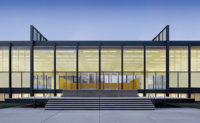The new U.S. Embassy in Baghdad, which is scheduled to open this month, will only be accessible to visitors who undergo extensive security checks. The State Department has tried to deflect attention from the compound, but Internet users got an unexpected peak at it when images were posted online this spring.

After a blogger discovered this rendering of the U.S. Embassy in Baghdad on Berger Devine Yaeger's Web site, The Associated Press, the British Broadcasting Corporation, and other news agencies published it.
Berger Devine Yaeger (BDY), of Kansas City, Missouri, and Sorg Associates, based in Washington, D.C., designed the embassy for a 104-acre site in Baghdad’s Green Zone. Tom Engelhardt, a left-leaning blogger and war critic, discovered renderings of the project on BDY’s Web site in May and began writing about them. The images were cartoonlike and offered little detail, but they included some bird’s-eye views. Citing concerns, the State Department soon ordered that they be removed; as of mid-August, BDY’s entire site was still listed as “under construction.”
Neither the State Department nor BDY would speak to record about the incident; Sorg also declined comment. It is unclear how long the images appeared on BDY’s Web site, or what kind of security breach their appearance there constituted. Engelhardt and other observers, though, doubt that they were significant. “You can get more information about the project from Google Earth than you can get from these renderings,” he says.
Despite the wall of secrecy that has since gone up around the Iraq project, one thing remains clear: The Baghdad complex will be the largest embassy in the world. The Los Angeles Times reported that the 27-building compound will be entirely self-sustaining, featuring its own power generation, water purification, and sewage treatment infrastructure, as well as housing for nearly 400 families, a school, and a fire station.
Other press accounts note that construction has been riddled with problems. Engineering News-Record, RECORD’s sister publication, reported that electrical faults forced the closure of temporary structures to house security guards, and that the State Department investigated allegations that the Kuwati construction contractor brought immigrant laborers to Iraq against their will.
For Engelhardt, the scale of the embassy remains this story’s most important aspect—particularly in light of U.S. military bases being constructed elsewhere in Iraq. “It’s hard not to see the embassy as part of a larger permanent infrastructure,” he says.




